2016 NISSAN TITAN maintenance
[x] Cancel search: maintenancePage 567 of 636
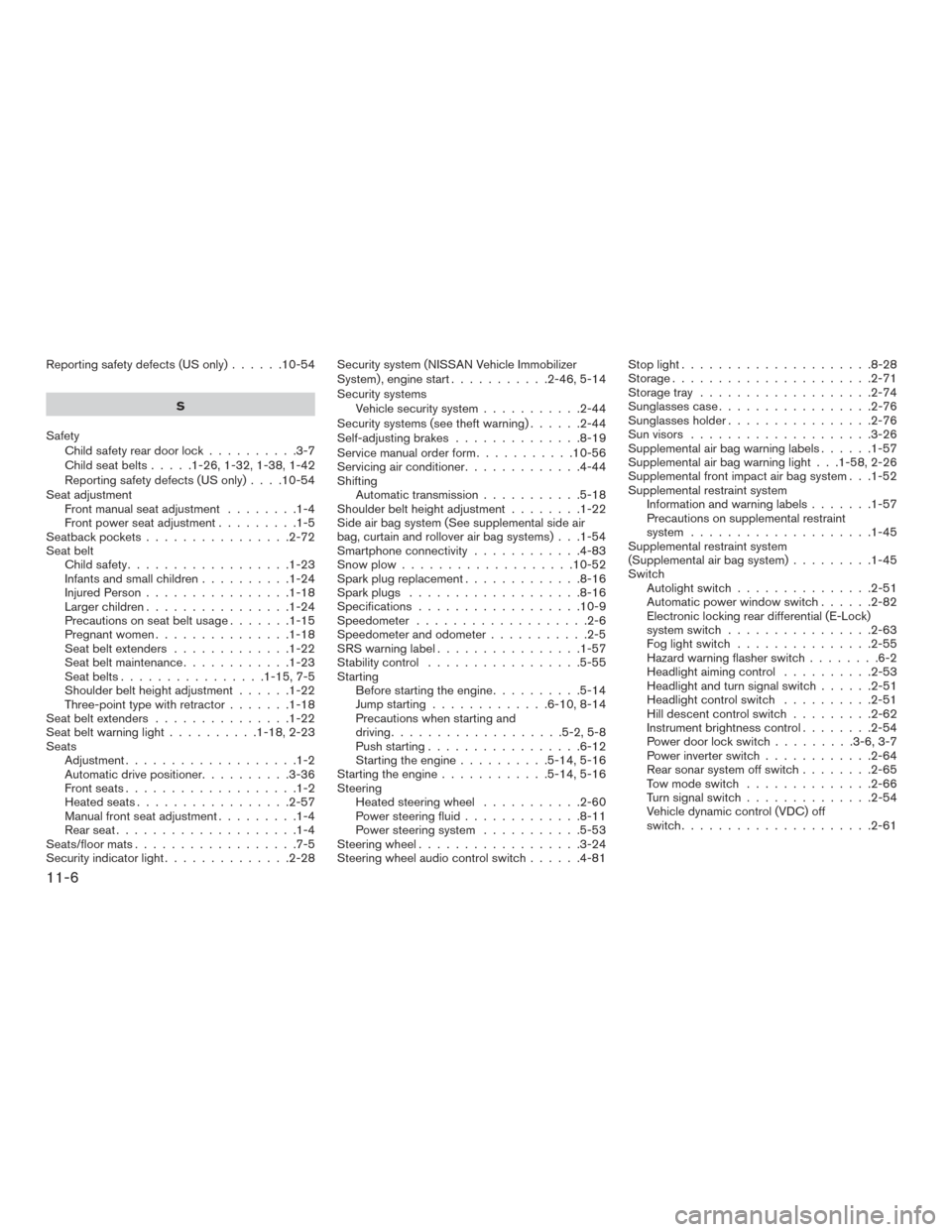
Reporting safety defects (US only)......10-54
S
Safety Child safety rear door lock ..........3-7
Childseatbelts.....1-26,1-32,1-38,1-42
Reporting safety defects (US only) ....10-54
Seat adjustment Front manual seat adjustment ........1-4
Front power seat adjustment .........1-5
Seatback pockets ................2-72
Seat belt Childsafety..................1-23
Infantsandsmallchildren..........1-24
Injured Person ................1-18
Largerchildren................1-24
Precautionsonseatbeltusage.......1-15
Pregnant women ...............1-18
Seat belt extenders .............1-22
Seat belt maintenance ............1-23
Seat belts ................1-15,7-5
Shoulder belt height adjustment ......1-22
Three-point type with retractor .......1-18
Seat belt extenders ...............1-22
Seatbeltwarninglight..........1-18,2-23
Seats Adjustment ...................1-2
Automatic drive positioner ..........3-36
Frontseats...................1-2
Heatedseats.................2-57
Manual front seat adjustment .........1-4
Rear seat ....................1-4
Seats/floor mats ..................7-5
Security indicator light ..............2-28 Security system (NISSAN Vehicle Immobilizer
System) , engine start
...........2-46,5-14
Security systems Vehicle security system ...........2-44
Security systems (see theft warning) ......2-44
Self-adjusting brakes ..............8-19
Service manual order form ...........10-56
Servicing air conditioner .............4-44
Shifting Automatic transmission ...........5-18
Shoulder belt height adjustment ........1-22
Side air bag system (See supplemental side air
bag, curtain and rollover air bag systems) . . .1-54
Smartphone connectivity ............4-83
Snow plow ...................10-52
Sparkplugreplacement.............8-16
Sparkplugs ...................8-16
Specifications ..................10-9
Speedometer ...................2-6
Speedometer and odometer ...........2-5
SRSwarninglabel................1-57
Stability control .................5-55
Starting Before starting the engine ..........5-14
Jump starting .............6-10,8-14
Precautions when starting and
driving ...................5-2,5-8
Push starting .................6-12
Starting the engine ..........5-14,5-16
Starting the engine ............5-14,5-16
Steering Heated steering wheel ...........2-60
Power steering fluid .............8-11
Power steering system ...........5-53
Steeringwheel..................3-24
Steering wheel audio control switch ......4-81Stoplight.....................8-28
Storage......................2-71
Storage tray
...................2-74
Sunglasses case .................
2-76
Sunglasses holder ................2-76
Sun visors ....................3-26
Supplemental air bag warning labels ......1-57
Supplemental air bag warning light . . .1-58, 2-26
Supplemental front impact air bag system . . .1-52
Supplemental restraint system Information and warning labels .......1-57
Precautions on supplemental restraint
system ....................1-45
Supplemental restraint system
(Supplemental air bag system) .........1-45
Switch Autolightswitch...............2-51
Automatic power window switch ......2-82
Electronic locking rear differential (E-Lock)
system switch ................2-63
Fog light switch ...............2-55
Hazard warning flasher switch ........6-2
Headlightaimingcontrol ..........2-53
Headlightandturnsignalswitch......2-51
Headlight control switch ..........2-51
Hilldescentcontrolswitch.........2-62
Instrument brightness control ........2-54
Power door lock switch .........3-6,3-7
Power inverter switch ............2-64
Rear sonar system off switch ........2-65
Tow mode switch ..............2-66
Turnsignalswitch..............2-54
Vehicle dynamic control (VDC) off
switch .....................2-61
11-6
Page 570 of 636
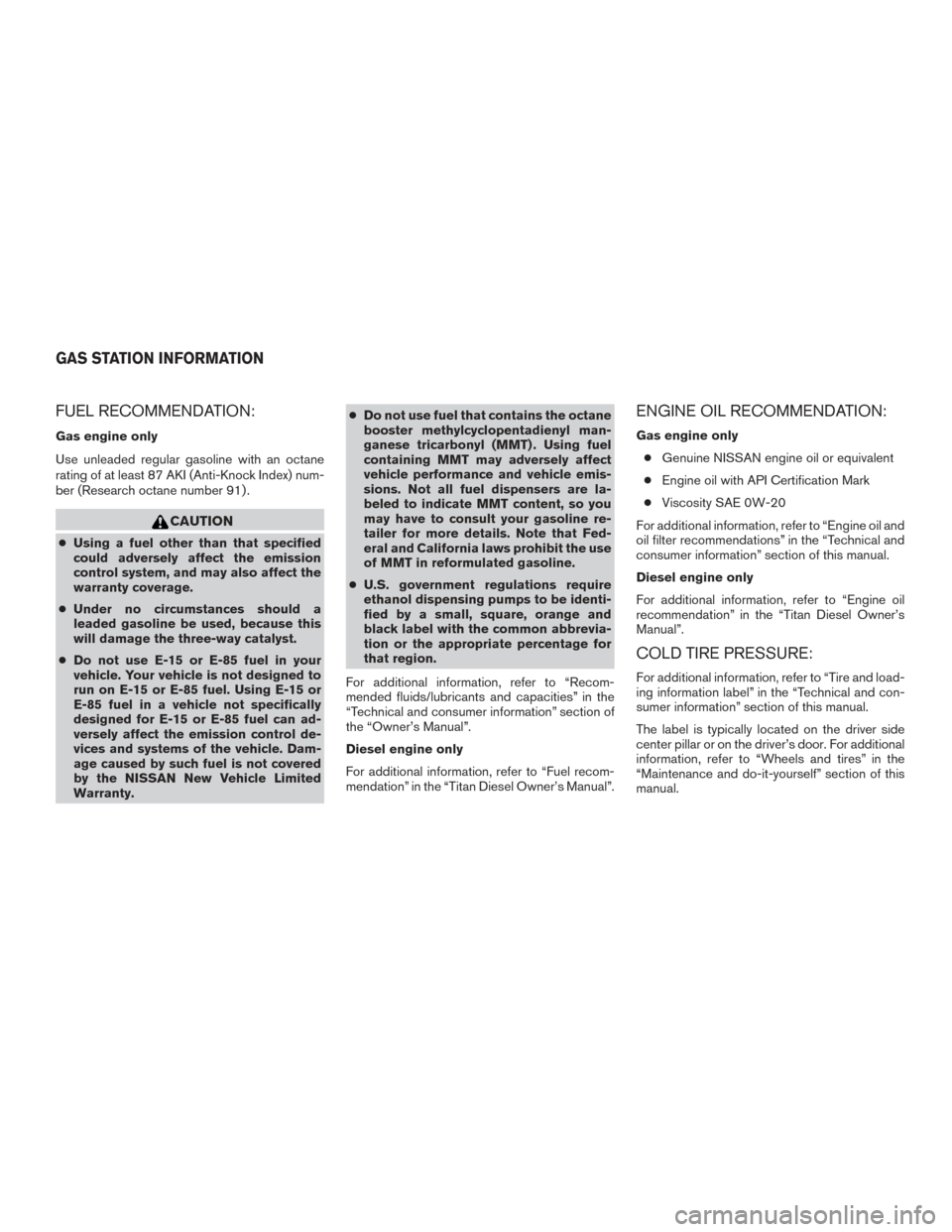
FUEL RECOMMENDATION:
Gas engine only
Use unleaded regular gasoline with an octane
rating of at least 87 AKI (Anti-Knock Index) num-
ber (Research octane number 91) .
CAUTION
●Using a fuel other than that specified
could adversely affect the emission
control system, and may also affect the
warranty coverage.
● Under no circumstances should a
leaded gasoline be used, because this
will damage the three-way catalyst.
● Do not use E-15 or E-85 fuel in your
vehicle. Your vehicle is not designed to
run on E-15 or E-85 fuel. Using E-15 or
E-85 fuel in a vehicle not specifically
designed for E-15 or E-85 fuel can ad-
versely affect the emission control de-
vices and systems of the vehicle. Dam-
age caused by such fuel is not covered
by the NISSAN New Vehicle Limited
Warranty. ●
Do not use fuel that contains the octane
booster methylcyclopentadienyl man-
ganese tricarbonyl (MMT) . Using fuel
containing MMT may adversely affect
vehicle performance and vehicle emis-
sions. Not all fuel dispensers are la-
beled to indicate MMT content, so you
may have to consult your gasoline re-
tailer for more details. Note that Fed-
eral and California laws prohibit the use
of MMT in reformulated gasoline.
● U.S. government regulations require
ethanol dispensing pumps to be identi-
fied by a small, square, orange and
black label with the common abbrevia-
tion or the appropriate percentage for
that region.
For additional information, refer to “Recom-
mended fluids/lubricants and capacities” in the
“Technical and consumer information” section of
the “Owner’s Manual”.
Diesel engine only
For additional information, refer to “Fuel recom-
mendation” in the “Titan Diesel Owner’s Manual”.
ENGINE OIL RECOMMENDATION:
Gas engine only ● Genuine NISSAN engine oil or equivalent
● Engine oil with API Certification Mark
● Viscosity SAE 0W-20
For additional information, refer to “Engine oil and
oil filter recommendations” in the “Technical and
consumer information” section of this manual.
Diesel engine only
For additional information, refer to “Engine oil
recommendation” in the “Titan Diesel Owner’s
Manual”.
COLD TIRE PRESSURE:
For additional information, refer to “Tire and load-
ing information label” in the “Technical and con-
sumer information” section of this manual.
The label is typically located on the driver side
center pillar or on the driver’s door. For additional
information, refer to “Wheels and tires” in the
“Maintenance and do-it-yourself” section of this
manual.
GAS STATION INFORMATION
Page 572 of 636
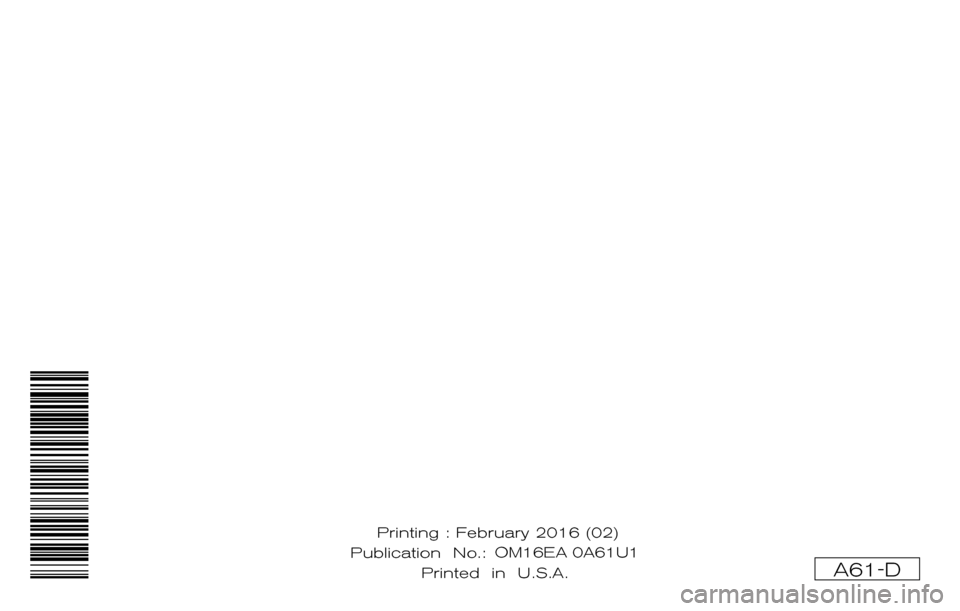
®
2016 TITAN
OWNER’S MANUAL
and MAINTENANCE INFORMATION
For your safety, read carefully and keep in this vehicle.
2016 NISSAN TITAN A61-D
A61-D
Printing : February 2016 (02)
Publication No.: OM1E 0A60U0 Printed in U.S.A.OM16EA 0A61U1
Page 573 of 636
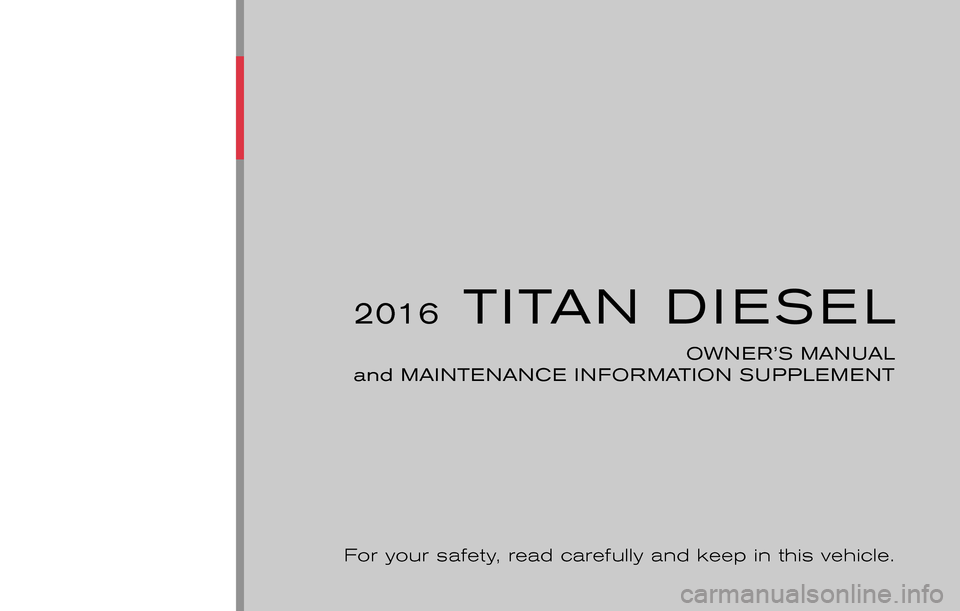
®
2016 TITAN DIESEL
OWNER’S MANUAL
and MAINTENANCE INFORMATION SUPPLEM ENT
For your safety, read carefully and keep in this vehicle.
+A61-D
Printing : March 2016 (03)
Publication No.: OM1E 0A60U0 Printed in U.S.A.OM16EA +A61U1
Page 579 of 636
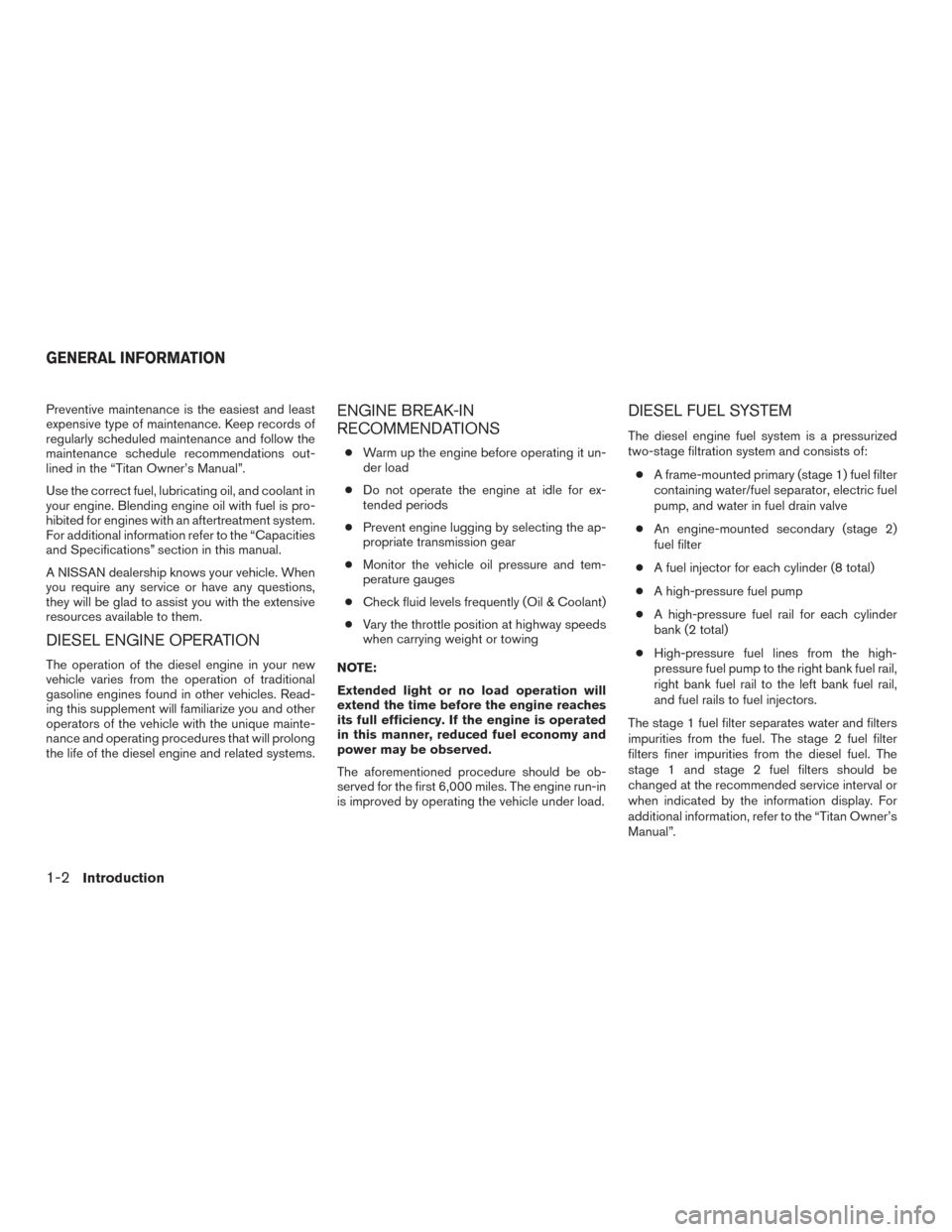
Preventive maintenance is the easiest and least
expensive type of maintenance. Keep records of
regularly scheduled maintenance and follow the
maintenance schedule recommendations out-
lined in the “Titan Owner’s Manual”.
Use the correct fuel, lubricating oil, and coolant in
your engine. Blending engine oil with fuel is pro-
hibited for engines with an aftertreatment system.
For additional information refer to the “Capacities
and Specifications” section in this manual.
A NISSAN dealership knows your vehicle. When
you require any service or have any questions,
they will be glad to assist you with the extensive
resources available to them.
DIESEL ENGINE OPERATION
The operation of the diesel engine in your new
vehicle varies from the operation of traditional
gasoline engines found in other vehicles. Read-
ing this supplement will familiarize you and other
operators of the vehicle with the unique mainte-
nance and operating procedures that will prolong
the life of the diesel engine and related systems.
ENGINE BREAK-IN
RECOMMENDATIONS
●Warm up the engine before operating it un-
der load
● Do not operate the engine at idle for ex-
tended periods
● Prevent engine lugging by selecting the ap-
propriate transmission gear
● Monitor the vehicle oil pressure and tem-
perature gauges
● Check fluid levels frequently (Oil & Coolant)
● Vary the throttle position at highway speeds
when carrying weight or towing
NOTE:
Extended light or no load operation will
extend the time before the engine reaches
its full efficiency. If the engine is operated
in this manner, reduced fuel economy and
power may be observed.
The aforementioned procedure should be ob-
served for the first 6,000 miles. The engine run-in
is improved by operating the vehicle under load.
DIESEL FUEL SYSTEM
The diesel engine fuel system is a pressurized
two-stage filtration system and consists of: ● A frame-mounted primary (stage 1) fuel filter
containing water/fuel separator, electric fuel
pump, and water in fuel drain valve
● An engine-mounted secondary (stage 2)
fuel filter
● A fuel injector for each cylinder (8 total)
● A high-pressure fuel pump
● A high-pressure fuel rail for each cylinder
bank (2 total)
● High-pressure fuel lines from the high-
pressure fuel pump to the right bank fuel rail,
right bank fuel rail to the left bank fuel rail,
and fuel rails to fuel injectors.
The stage 1 fuel filter separates water and filters
impurities from the fuel. The stage 2 fuel filter
filters finer impurities from the diesel fuel. The
stage 1 and stage 2 fuel filters should be
changed at the recommended service interval or
when indicated by the information display. For
additional information, refer to the “Titan Owner’s
Manual”.
GENERAL INFORMATION
1-2Introduction
Page 580 of 636
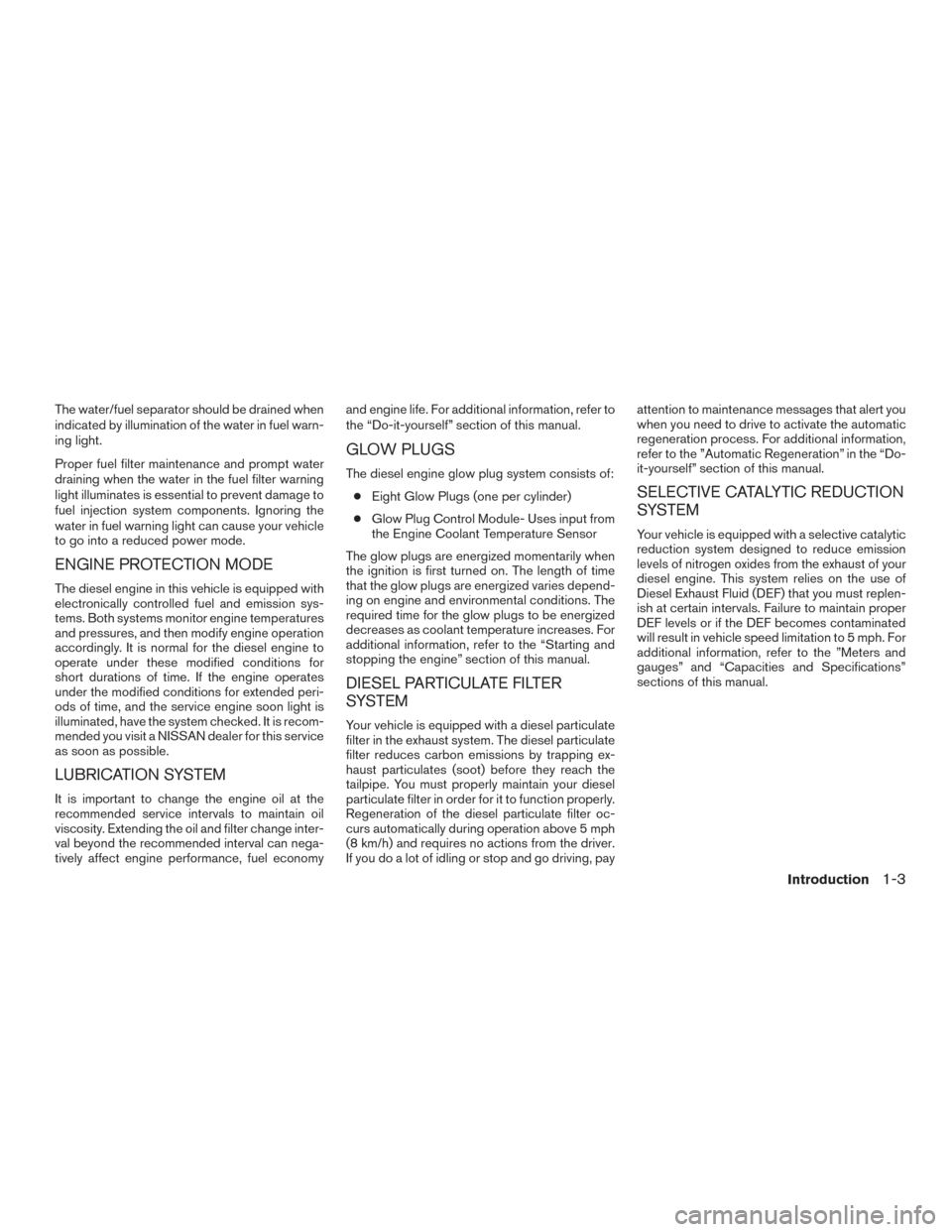
The water/fuel separator should be drained when
indicated by illumination of the water in fuel warn-
ing light.
Proper fuel filter maintenance and prompt water
draining when the water in the fuel filter warning
light illuminates is essential to prevent damage to
fuel injection system components. Ignoring the
water in fuel warning light can cause your vehicle
to go into a reduced power mode.
ENGINE PROTECTION MODE
The diesel engine in this vehicle is equipped with
electronically controlled fuel and emission sys-
tems. Both systems monitor engine temperatures
and pressures, and then modify engine operation
accordingly. It is normal for the diesel engine to
operate under these modified conditions for
short durations of time. If the engine operates
under the modified conditions for extended peri-
ods of time, and the service engine soon light is
illuminated, have the system checked. It is recom-
mended you visit a NISSAN dealer for this service
as soon as possible.
LUBRICATION SYSTEM
It is important to change the engine oil at the
recommended service intervals to maintain oil
viscosity. Extending the oil and filter change inter-
val beyond the recommended interval can nega-
tively affect engine performance, fuel economyand engine life. For additional information, refer to
the “Do-it-yourself” section of this manual.
GLOW PLUGS
The diesel engine glow plug system consists of:
● Eight Glow Plugs (one per cylinder)
● Glow Plug Control Module- Uses input from
the Engine Coolant Temperature Sensor
The glow plugs are energized momentarily when
the ignition is first turned on. The length of time
that the glow plugs are energized varies depend-
ing on engine and environmental conditions. The
required time for the glow plugs to be energized
decreases as coolant temperature increases. For
additional information, refer to the “Starting and
stopping the engine” section of this manual.
DIESEL PARTICULATE FILTER
SYSTEM
Your vehicle is equipped with a diesel particulate
filter in the exhaust system. The diesel particulate
filter reduces carbon emissions by trapping ex-
haust particulates (soot) before they reach the
tailpipe. You must properly maintain your diesel
particulate filter in order for it to function properly.
Regeneration of the diesel particulate filter oc-
curs automatically during operation above 5 mph
(8 km/h) and requires no actions from the driver.
If you do a lot of idling or stop and go driving, pay attention to maintenance messages that alert you
when you need to drive to activate the automatic
regeneration process. For additional information,
refer to the ”Automatic Regeneration” in the “Do-
it-yourself” section of this manual.
SELECTIVE CATALYTIC REDUCTION
SYSTEM
Your vehicle is equipped with a selective catalytic
reduction system designed to reduce emission
levels of nitrogen oxides from the exhaust of your
diesel engine. This system relies on the use of
Diesel Exhaust Fluid (DEF) that you must replen-
ish at certain intervals. Failure to maintain proper
DEF levels or if the DEF becomes contaminated
will result in vehicle speed limitation to 5 mph. For
additional information, refer to the ”Meters and
gauges” and “Capacities and Specifications”
sections of this manual.
Introduction1-3
Page 584 of 636
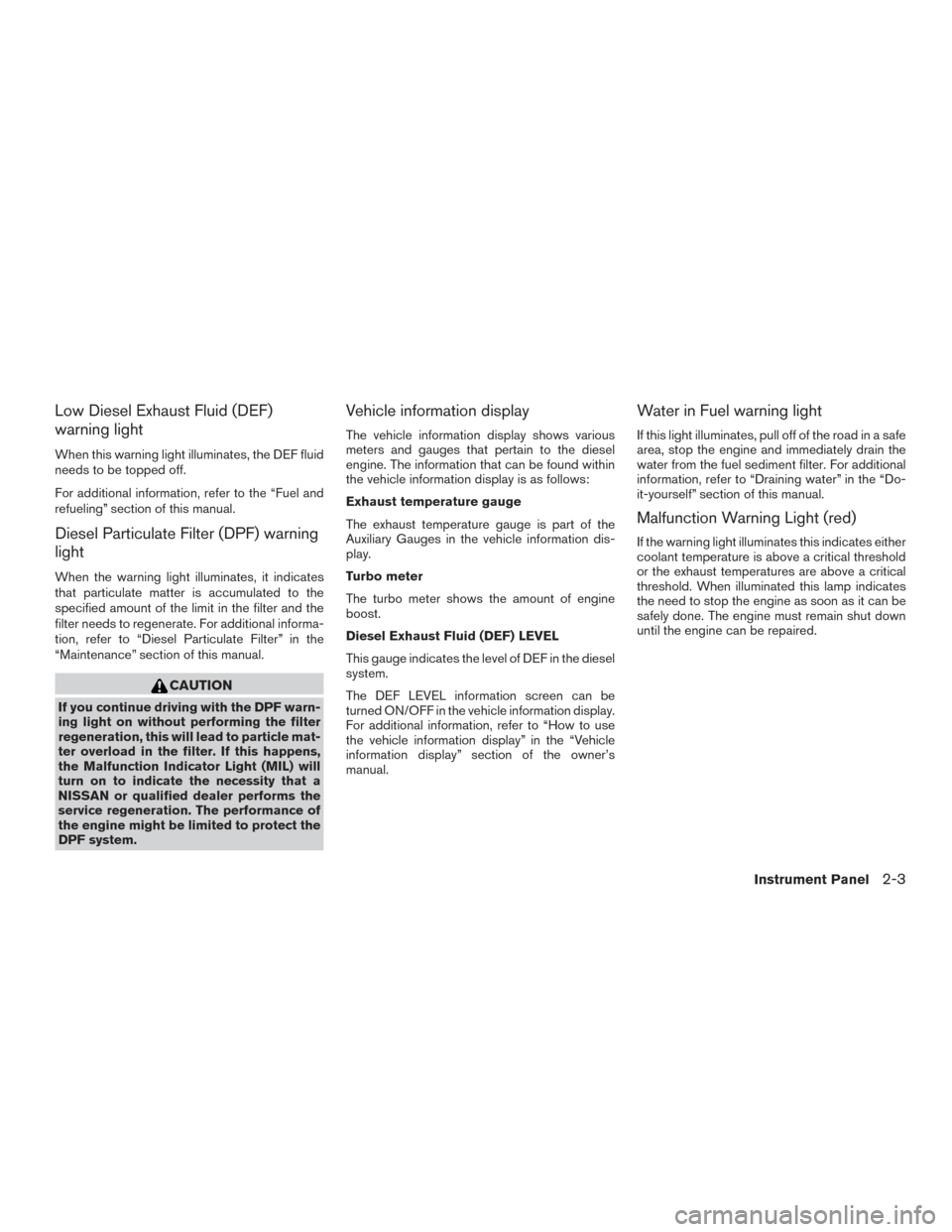
Low Diesel Exhaust Fluid (DEF)
warning light
When this warning light illuminates, the DEF fluid
needs to be topped off.
For additional information, refer to the “Fuel and
refueling” section of this manual.
Diesel Particulate Filter (DPF) warning
light
When the warning light illuminates, it indicates
that particulate matter is accumulated to the
specified amount of the limit in the filter and the
filter needs to regenerate. For additional informa-
tion, refer to “Diesel Particulate Filter” in the
“Maintenance” section of this manual.
CAUTION
If you continue driving with the DPF warn-
ing light on without performing the filter
regeneration, this will lead to particle mat-
ter overload in the filter. If this happens,
the Malfunction Indicator Light (MIL) will
turn on to indicate the necessity that a
NISSAN or qualified dealer performs the
service regeneration. The performance of
the engine might be limited to protect the
DPF system.
Vehicle information display
The vehicle information display shows various
meters and gauges that pertain to the diesel
engine. The information that can be found within
the vehicle information display is as follows:
Exhaust temperature gauge
The exhaust temperature gauge is part of the
Auxiliary Gauges in the vehicle information dis-
play.
Turbo meter
The turbo meter shows the amount of engine
boost.
Diesel Exhaust Fluid (DEF) LEVEL
This gauge indicates the level of DEF in the diesel
system.
The DEF LEVEL information screen can be
turned ON/OFF in the vehicle information display.
For additional information, refer to “How to use
the vehicle information display” in the “Vehicle
information display” section of the owner’s
manual.
Water in Fuel warning light
If this light illuminates, pull off of the road in a safe
area, stop the engine and immediately drain the
water from the fuel sediment filter. For additional
information, refer to “Draining water” in the “Do-
it-yourself” section of this manual.
Malfunction Warning Light (red)
If the warning light illuminates this indicates either
coolant temperature is above a critical threshold
or the exhaust temperatures are above a critical
threshold. When illuminated this lamp indicates
the need to stop the engine as soon as it can be
safely done. The engine must remain shut down
until the engine can be repaired.
Instrument Panel2-3
Page 588 of 636
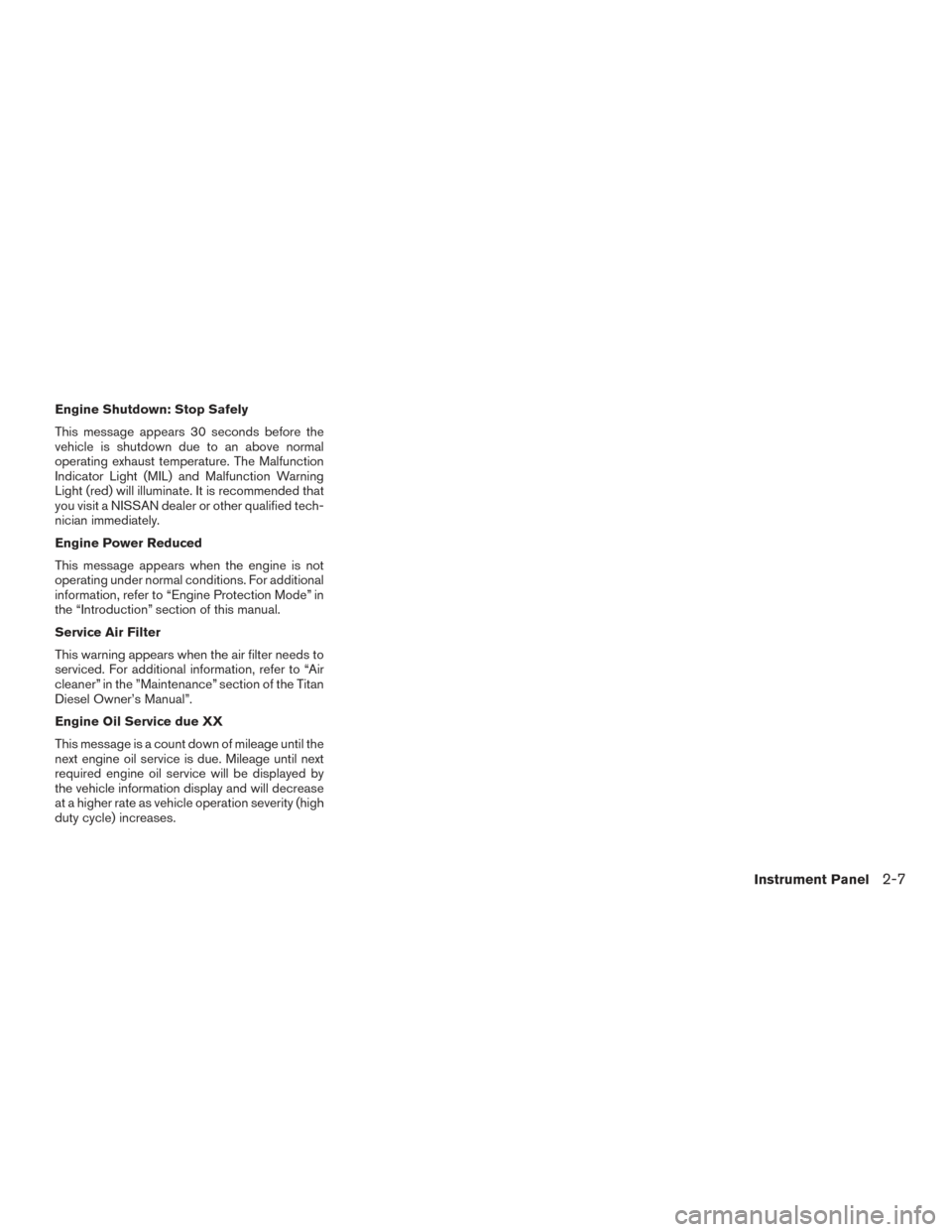
Engine Shutdown: Stop Safely
This message appears 30 seconds before the
vehicle is shutdown due to an above normal
operating exhaust temperature. The Malfunction
Indicator Light (MIL) and Malfunction Warning
Light (red) will illuminate. It is recommended that
you visit a NISSAN dealer or other qualified tech-
nician immediately.
Engine Power Reduced
This message appears when the engine is not
operating under normal conditions. For additional
information, refer to “Engine Protection Mode” in
the “Introduction” section of this manual.
Service Air Filter
This warning appears when the air filter needs to
serviced. For additional information, refer to “Air
cleaner” in the ”Maintenance” section of the Titan
Diesel Owner’s Manual”.
Engine Oil Service due XX
This message is a count down of mileage until the
next engine oil service is due. Mileage until next
required engine oil service will be displayed by
the vehicle information display and will decrease
at a higher rate as vehicle operation severity (high
duty cycle) increases.
Instrument Panel2-7